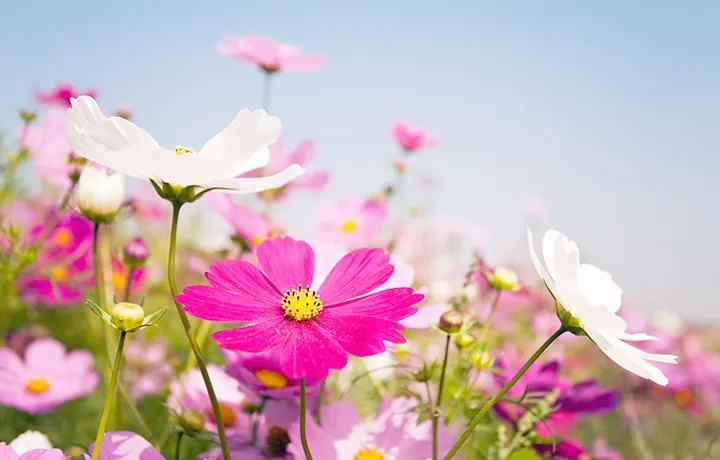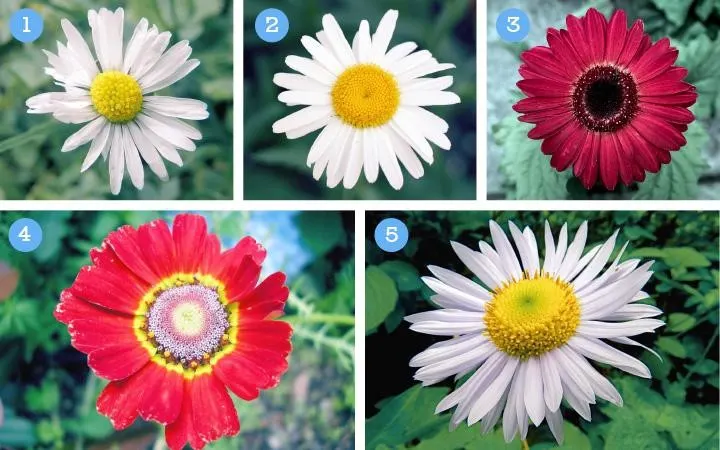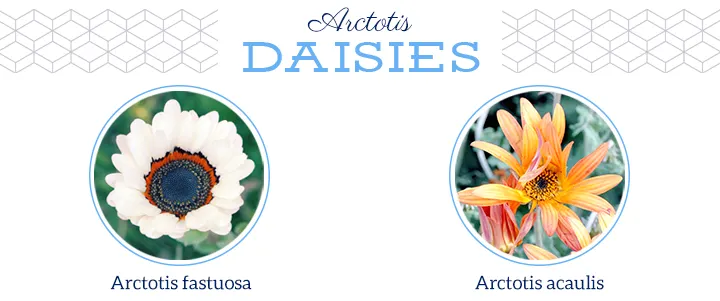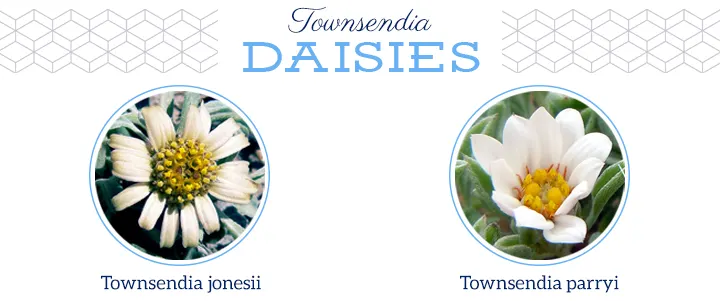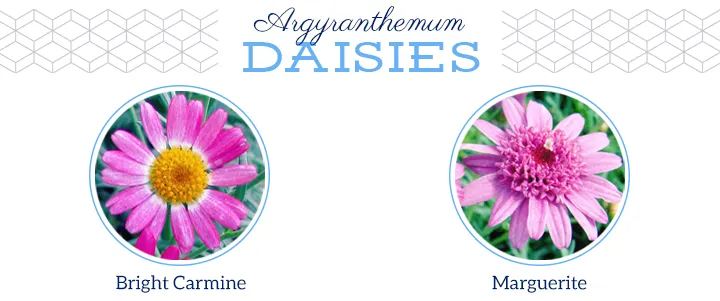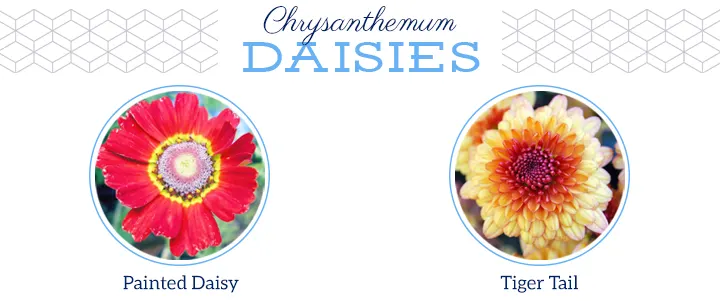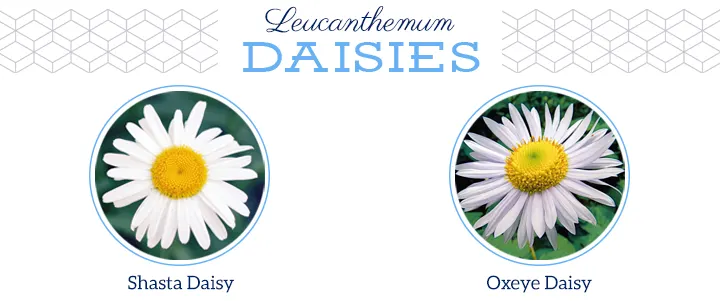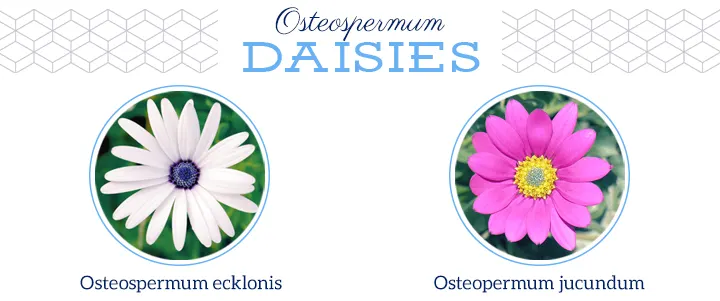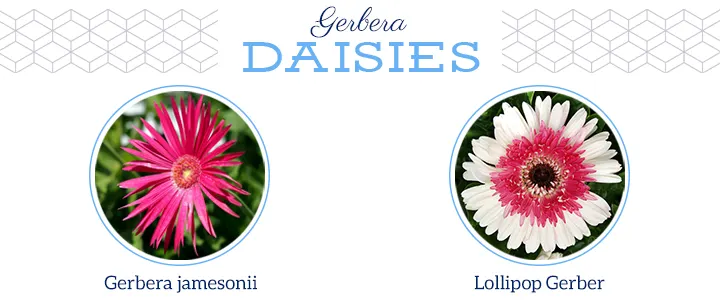May 16, 2016
Types of Daisies: A Visual Compendium
“He loves me, he loves me not.” The classic daisy is actually more than just the topic of a childhood rhyme. From Celtic legends to Ancient Roman mythology, different types of daisies have long been revered as symbols of purity, love, and transformation.
Did you know that the name “daisy” comes from the term “day’s eye?” This name is derived from the fact that the head of the common daisy closes at night, and re-opens in the morning.
Most people think of daisies as the classic white flower bearing a yellow center and adorned with long delicate petals. However, there are many types of daisies that exist today ranging from the exotic “Crazy” Shasta daisy to the colorful Gerber Daisy. These daisy types come in a wide assortment of colors and shapes, and are a far stretch from the classic white daisy that we all know.
1. English Daisy
With its classic yellow center and long white petals, the English daisy is also referred to as the common daisy. With its origins in Northern Europe, this hardy perennial has been distributed widely around the world. In the United States, it has unfortunately become a common weed. However, there are many other varieties of daisies bred from the English daisy that have a much better reputation, and can be found in the Bellis genus.
2. Shasta Daisy
The Shasta daisy is another classic daisy that bears a very similar resemblance to the English daisy. The Shasta daisy, however, has a much larger yellow center and grows much taller, often reaching stem heights of two to three feet tall. Although popular in the United States, the Shasta daisy did not come into existence on its own. It was bred as a hybrid by a botanist named Luther Burbank, in Mt. Shasta, California, using three other daisies including the wild Oxeye daisy, also from the Leucanthemum family.
3. Gerbera Daisy
The Gerber daisy is one of the world’s most popular daisies. Available in a large variety of bright colors and showy flower heads, these daisies have become widely cultivated. Exotic cultivars include the Lollipop Gerber daisy, which has a large flower head that consists of a thick inner circle of petals that’s oftentimes a different color from its outer petals. Because Gerber daisies are so unique, they have formed their own genus called the Gerbera genus.
4. Painted Daisy
The Painted daisy is a very popular daisy in gardens, due to their ability to attract butterflies. Its fern-like leaves make it an attractive plant even after the flowers have bloomed. They are also quite effective at repelling pesky insects and are virtually disease-free. The Painted daisy comes in a variety of bright colors including, white, red, purple, and pink and which are all part of the Chrysanthemum genus.
5. Oxeye Daisy
Scientifically known as Leucanthemum vulgare, the oxeye daisy is a wildflower that shares its European origins with the English daisy. Its wild nature lends itself to spreading easily, and being drought tolerant. Although beautiful, the oxeye daisy has been known to plague the fields and pastures of Europe where today it is considered a common weed.
How Daisy Types are Classified
To illustrate just how expansive the daisy family is, we’ve created a comprehensive outline of how the most popular daisies are taxonomically classified, accompanied with a visual compendium that includes 94 of the world’s most popular daisies.
Family: Asteraceae
The daisy belongs to the Asteraceae family. With over 1,500 genera and 23,000 species, it is the largest family of flowering plants. Daisies share this family along with sunflowers, chrysanthemums and even lettuce! Flowers belonging to the daisy family are characterized by a single flower head composed of many tiny flowers (sometimes over a hundred) called florets, which are surrounded by rays of longer petals. The “aster” in Asteraceae refers to the resulting star-shaped construction of the flower heads belonging to this family. Because there are two flowers that make up one, the Asteraceae family is commonly referred to as the Compositae or “composite” family.
Subfamily: Asteroideae
The Asteroideae subfamily contains over 70% of the species in the entire Asteraceae family. It contains over 21 tribes, including: Astereae, Anthemideae, Calenduleae, Heliantheae, and Perityleae, which include most types of daisies.
Tribe: Astereae
The Astereae tribe consists of over 2,800 species and includes many of the most recognizable daisy flowers we all know. Many of these daisies are classified into various genera, including: Bellis, Chaetopappa, and Townsendia.
Genus: Arctotis
Native to Africa, many of these flowers have now become naturalized in the United States. Some daisies within this genus are stemless, such as the Arctotis acaulis. The name Arctotis is derived from the Greek word “arktos”, meaning bear, which could refer to the shaggy hairs found on the fruit.
Genus: Bellis
The Bellis genus includes the common daisy, also known as the English daisy (Bellis perennis), as well as other common daisy species. The common daisy originated in Europe, and its popularity fueled its distribution across the globe to the United States, where today it has become a common weed. Characterized by a rich yellow center with rays of long white petals, the flowers in this genus have the quintessential characteristics we all recognize in a classic daisy.
Genus: Monoptilon
Known as the desert star, or daisy desertstar, these types of daisies are native to the southwest desert of the United States. Most commonly found in the Mojave Desert, the desertstar is a small wildflower that thrives in dry and open areas and begin to flower in late winter.
Genus: Townsendia
Known as the Townsend Daisies, the name Townsendia is derived from the birthplace of the man who discovered this genus of daisies. William Jackson Hooker made his discovery in 1833, and was from a town called Townsend, Pennsylvania. All 25 species of Townsend daisies are native to western North America and flourish in dryer climates.
Tribe: Anthemideae
The tribe Anthemideae contains 111 genera and approximately 1800 species. Members of this tribe have mostly originated from Central Asia, the Mediterranean and Southern Africa. Many of these plants have natural compounds that act as anti-infectious agents and are used in pharmaceuticals.
Genus: Argyranthemum
Known as the marguerite daisies (Argyranthemum frutescens), all of the subspecies within this genus are cultivars that have resulted from hybridization. These daisies are effective at attracting butterflies, and have become quite popular in gardening due to their wide array of colors.
Genus: Chrysanthemum
The Chrysanthemum gets its name from the Greek words “chrysos”, meaning gold, and “anthemom”, meaning flower. This is because the first chrysanthemums that appeared in China were golden-colored and were used for their herbal healing properties that ranged from reducing high blood pressure to lowering cholesterol. A common synonym for this genus is Tanacetum, and the two names are used interchangeably. The most common daisy in the Chrysanthemum genus is the painted daisy (Tanacetum coccineum).
Genus: Leucanthemum
This genus is home to the oxeye daisy (Leucanthemum vulgare), a wild daisy that gave rise to the Shasta daisy (Leucanthemum x superbum). This species was developed by Luther Burbank who crossed a European oxeye daisy with three other Leucanthemum daisies plus a Japanese field daisy. Today, the Shasta daisy is the most popular daisy in this genus from which many other ornamental cultivars have been bred.
Tribe: Calenduleae
The Calenduleae tribe is one of the smaller tribes of the Asteraceae family. Flowers within this tribe usually have quite showy flower heads, and the plant types within this tribe vary from herbs to shrubs. The tribe gets its name from Calendula – an anti-inflammatory substance that is present within the petals of marigolds, which belong to the Calendula genus within this tribe. Although the Calendula genus mostly includes marigolds, there are several daisy types within this tribe that belong to the Osteospermum genus.
Genus: Osteospermum
Also known as the “daisybushes”, these perennial daisies are native to Africa. However, due to their popularity, these African daisies have been distributed around the world and many exotic cultivars have been bred. Most of these cultivars are hybridizations of the two main Osteospermum species: Osteopermum jucundum and Osteopermum ecklonis. Daisies belonging to this genus are not to be confused with the Dimorphotheca – which look highly similar but are annuals instead of perennials.
Tribe: Heliantheae
There are 2,500 species within this tribe, with the most recognizable being the sunflower. Other common plants include echinacea, stevia and zinnias. Besides flowers, many of the plants in this tribe are also shrubs and herbs that grow in dryer climates.
Genus: Echinacea
Also known as coneflowers, flowers belonging to this genus exhibit prickly spines on the flower head. Its name is actually derived from the Greek word “echinos”, meaning sea urchin or hedgehog. These drought-tolerant plants are well-known for their medicinal properties and are used in herbal remedies.
Subfamily: Mutisioideae
This subfamily contains 44 genera and 630 species. Plants from this subfamily are primarily found in South America, with the exception of three genera – the most popular of which is the Gerbera genus.
Tribe: Mutisieae
The Mutisieae tribe is one of three major tribes of the Mutisioideae subfamily, containing 14 genera and 200 species. There has been much debate as to the lineage of this particular tribe, however recent research has suggested that plants belonging to this tribe are differentiated enough from the other existing tribes to be classified as its own group.
Genus: Gerbera
Originating from Africa, daisies from this genus are largely cultivated around the world today for their showy flowers. Most cultivars of the gerbera daisies that we see today are hybrids of Gerbera jamesonii and Gerbera viridifolia. These two daisy species are also known as Transvaal or African daisies due to their origins in South Africa. The name Gerber refers to Thomas A. Gerbera, a botanist who traveled around Europe studying plants.
Types of Daisies Compendium
As you can see, daisies have origins that range from Europe to China, and from Africa all the way to North America. To illustrate the scope of all the different daisy varieties that exist, we’ve created a compendium of the most popular daisies that shows how these flowers are categorized.
Who knew that the world of daisies could be so vast? It’s clear to see that the name “daisy” does not only pertain to the classic white flower with the yellow center. If you’re feeling inspired by daisies, you can browse our daisy bouquets, which feature the beautiful Gerbera daisies mentioned in this guide! If you’d like to know more about other types of flowers, we’ve also created other visual compendiums for types of roses and types of orchids as well.
Share this Image On Your Site
Please include attribution to FTD.com with this graphic.
Resources
www.davesgarden.com 1, 2 | www.osteospermum.com 1, 2 | www.botanical-online.com | www.newworldencyclopedia.org | www.plants.usda.gov | www.osteospermum.com | www.wildflower.org | www.compgenomics.ucdavis.edu | www.namesofflowers.net | www.herbwisdom.com | www.books.google.it | www.swcoloradowildflowers.com | www.gardeningknowhow.com | www.link.springer.com | www.fireflyforest.com | www.perennials.com | www.plantzafrica.com | www.gerbera.org | www.missouribotanicalgarden.org | www.cityflowers.co.in | www.mums.org | www.bgbm.org | www.researchgate.net
www.wildflowers-and-weeds.com | www.chicagobotanic.org | www.gardenia.net
Image sources
Arctotis acaulis CC Image courtesy of Lazaregagnidze on Wikimedia Commons
Chaetopappa ericoides, Townsendia jonesii CC Image courtesy of Stan Shebs on Wikimedia Commons
Arctotis grandis CC Image courtesy of Miwasatoshi on Wikimedia Commons
Arctotis arctoides CC Image courtesy of Alexey Yakovlev on Flickr
Arctotis stoechadifolia CC Image courtesy of Winfried Bruenken (Amrum) on Wikimedia Commons
Arctotis venusta CC Image courtesy of Udo Schröter on Flickr
Arctotis hirsuta CC Image courtesy of South African Tourism on Flickr
Southern Daisy CC Image courtesy of Alvesgaspar on Wikimedia Commons
Blue Eyed Daisy CC Image courtesy of FarOutFlora on Flickr
Chrysanthemum japonense, Chrysanthemum indicum, Dalmatian Chrysanthemum, Tasso Pink, Tasso White CC Image courtesy of KENPEI on Wikimedia Commons
Robella CC Image courtesy of Jebulon on Wikimedia Commons
Rob Roy CC Image courtesy of André Karwath aka Aka on Wikimedia Commons
Monstrosa CC Image courtesy of Gareth Williams on Flickr
Townsendia annua CC Image courtesy of Petrified Forest on Flickr
Townsendia florifer, Townsendia incana, Townsendia parryi CC Image courtesy of Matt Lavin on Flickr
Townsendia minima CC Image courtesy of Miguel Vaca on Flickr
Townsendia aprica CC Image courtesy of USFWS Mountain-Prairie Follow on Flickr
Monoptilon bellidiforme, Monoptilon bellioides CC Image courtesy of Joshua Tree National Park on Flickr
Bright Carmine, Cape Daisy Purple Illusion, Jaune Butterfly, Leucanthemum aglaia, Margarita Bronze, Reflection Pink, Reflection Yellow Cream, Vanilla Butterfly, Vanilla Spoon CC Image courtesy of Serres Fortier on Flickr
Comet Pink, Leucanthemum vulgare CC Image courtesy of Peter Stevens on Flickr
Leucanthemum maximum CC Image courtesy of Xavier Caballe on Flickr
Shasta Daisy CC Image courtesy of Jim, the Photographer on Flickr
Leucanthemum “Becky” CC Image courtesy of wundoroo on Flickr
Leucanthemum graminifolium CC Image courtesy of Kamil Konowalik on Wikimedia Commons
Leucanthemum lacustre, Osteospermum ecklonis CC Image courtesy of Alvesgaspar on Wikimedia Commons
Leucanthemum “Crazy Daisy” CC Image courtesy of Andrey Korzun on Wikimedia Commons
Argyranthemum frutescens CC Image courtesy of Forest & Kim Starr on Wikimedia Commons
Precioso Dulce Limon CC Image courtesy of jacinta lluch valero on Flickr
Supernova Carmine CC Image courtesy of jewel o’ the desert Follow on Flickr
Blue Marguerite CC Image courtesy of devra on Flickr
Tiger Tail CC Image courtesy of Ronincmc on Wikimedia Commons
Painted Daisy CC Image courtesy of Christine Majul on Flickr
Chrysanthemum weyrichii CC Image courtesy of Ghislain118 (AD) on Wikimedia Commons
South African Daisy CC Image courtesy of Dick Culbert on Flickr
Whirligig CC Image courtesy of nick fullerton on Flickr
Osteospermum barbarae CC Image courtesy of *FlowerGirl* on Flickr
Osteospermum fruticosum CC Image courtesy of Thangaraj Kumaravel on Flickr
Pink Whirls CC Image courtesy of Thomas Quine on Flickr
Lemon Symphony CC Image courtesy of Raul654 on Wikimedia Commons
Osteospermum jucundum CC Image courtesy of Dick Culbert on Flickr
Passion Mix CC Image courtesy of AntanO on Wikimedia Commons
Narrow-leaf Coneflower CC Image courtesy of Dy-e on Wikimedia Commons
Pale Purple Coneflower CC Image courtesy of Joshua Mayer on Flickr
Yellow Coneflower CC Image courtesy of Ram-Man on Wikimedia Commons
Smooth Coneflower CC Image courtesy of Sesamehoneytart on Wikimedia Commons
Fatal Attraction CC Image courtesy of Elvert Barnes on Flickr
All That Jazz, Bravado, Harvest Moon, Lilliput, Pink Double Delight, Pixie Meadowbrite, Summer Sky, Sundown, Sunrise, Tiki Torch, White Swan CC Image courtesy of F. D. Richards on Flickr
Gerbera jamesonii CC Image courtesy of Richard Keeler Follow on Flickr
Gerbera viridifoliai CC Image courtesy of JMK on Wikimedia Commons
Kir Red CC Image courtesy of ООО «АЗИМУТ Хотелс Компани» on Wikimedia Commons

